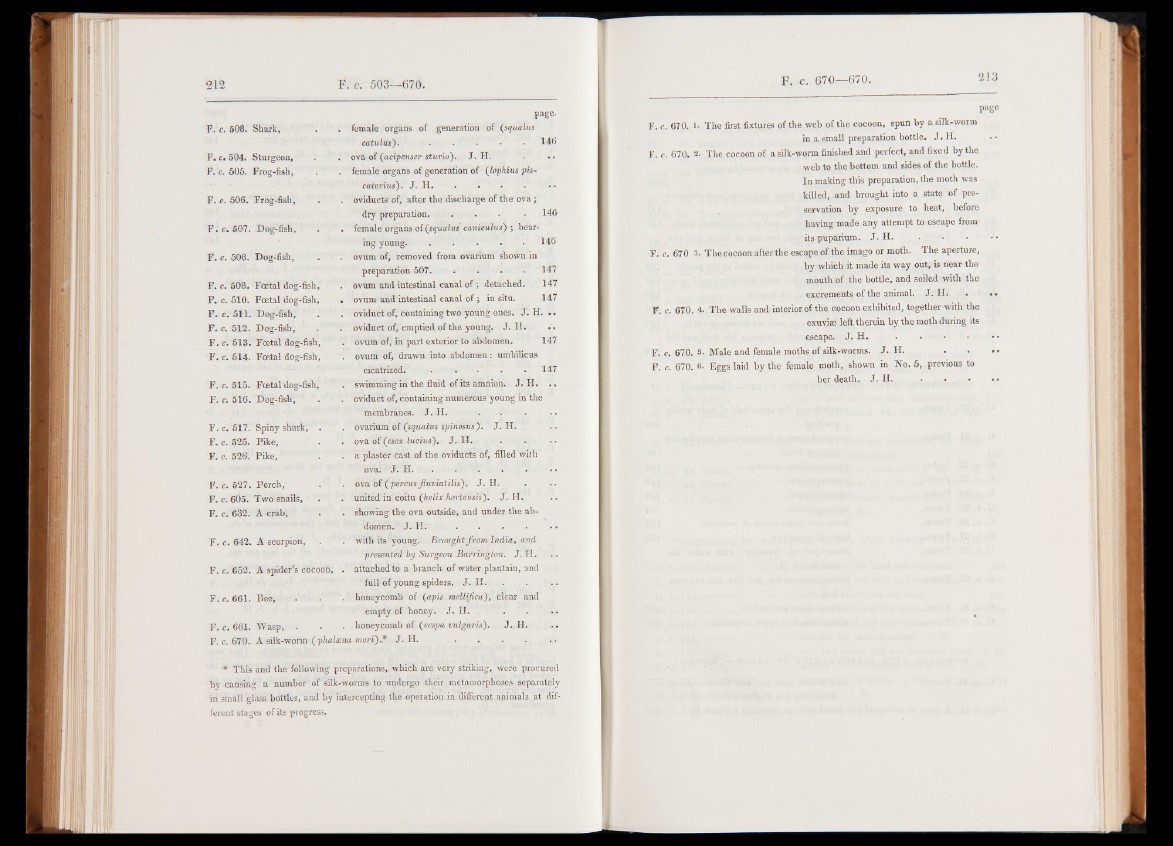
F. c. 508. Shark,
F. c. 504.
F. c. 505.
Sturgeon,
Frog-fish,
F. c. 506. Frog-fish,
F . c. 507. Dog-fish,
F. c. 508. Dog-fish,
F. c. 508.
F. c. 510.
F. c. 511.
F. c. 512.
F. c. 513.
F. c. 514.
F. c. 515.
F, c. 516.
F. c. 517.
F. c. 525.
F. c. 526.
F. c. 527.
F. c. 605.
F. c. 632.
F. c. 642.
F. c. 652.
F. c. 661.
F. c. 661.
F. c. 670.
Foetal dog-fish,
Foetal dog-fish,
Dog-fish,
Dog-fish,
Foetal dog-fish.
Foetal dog-fish,
Foetal dog-fish,
Dog-fish,
Spiny shark, .
Pike,
Pike,
Perch,
Two snails,
A crab,
A scorpion, .
A spider’s cocoon,
Bee,
Wasp, .
page,
female organs of generation of (squalus
catulus). . . . • • 146
ova of ([acipenser sturio'). J. H. . • •
female organs of generation of (lophius pis-
catorius). J. H. . . •
oviducts of, after the discharge of the ova;
dry preparation. . . . . 146
female organs of (squalus caniculus) ; bearmg
young. 146
ovum of, removed from ovarium shown in
preparation 507. . . . . 147
ovum and intestinal canal o f; detached. 147
ovum and intestinal canal of ; in situ. 147
oviduct of, containing two young ones.' J. H. ..
oviduct of, emptied of the young. J. H.
ovum of, in part exterior to abdomen. 147
ovum of, drawn into abdomen: umbilicus
cicatrized. . . . . . 1 4 7
swimming in the fluid of its amnion. J. H. ..
oviduct of, containing numerous young in the
membranes. J. H.
ovarium of (■squalus spinosus). J. H.
ova of (esox Indus'). J. H.
a plaster cast of the oviducts of, filled with
ova; ■ J. H.
ova of (percus fluviatilis). J. H.
united in coitu (helix hortensis)'. J. H.
showing the ova outside, and under the abdomen.
J. H.
with its young. Brought from India, and
presented by Surgeon Barrington. J. FI.
attached to a branch of water plantain, and
full of young spiders. J. H.
honeycomb of (apis mellificu), clear and
empty of honey. J. H.
honeycomb of (vespa vulgaris). J. H.
A silk-worm ( phalcena mori) .* J. H.
* This and the following preparations, which are very striking, were procured
by causing a number of silk-worms to undergo their metamorphoses separately
in small glass bottles, and by intercepting the operation in different animals at different
stages of its progress.
page
F. c. 670. I- The first fixtures of the web of the cocoon, spun by a silk-worm
in a small preparation bottle. J. FI.
F. c. 670. The cocoon of a silk-worm finished and perfect, and fixed by the
web to the bottom and sides of the bottle.
In making this preparation, the moth was
killed, and brought into a state of preservation
by exposure to heat, before
having made any attempt to escape from
its puparium. J. H.
F. c. 670 3- The cocoon after the escape of the imago or moth. The aperture,
by which it made its way out, is near the
mouth of the bottle, and soiled with the
excrements of the animal. J. H.
F. c. 670. 4. The walls and interior of the cocoon exhibited, together with the
exuviae left therein by the moth during its
- escape. J. H.
F. c. 670. 5- Male and female moths of silk-worms. J. H.
F. c. 670. 6. Eggs laid by the female moth, shown in No. 5, previous to
her death. J. H. . . . . •